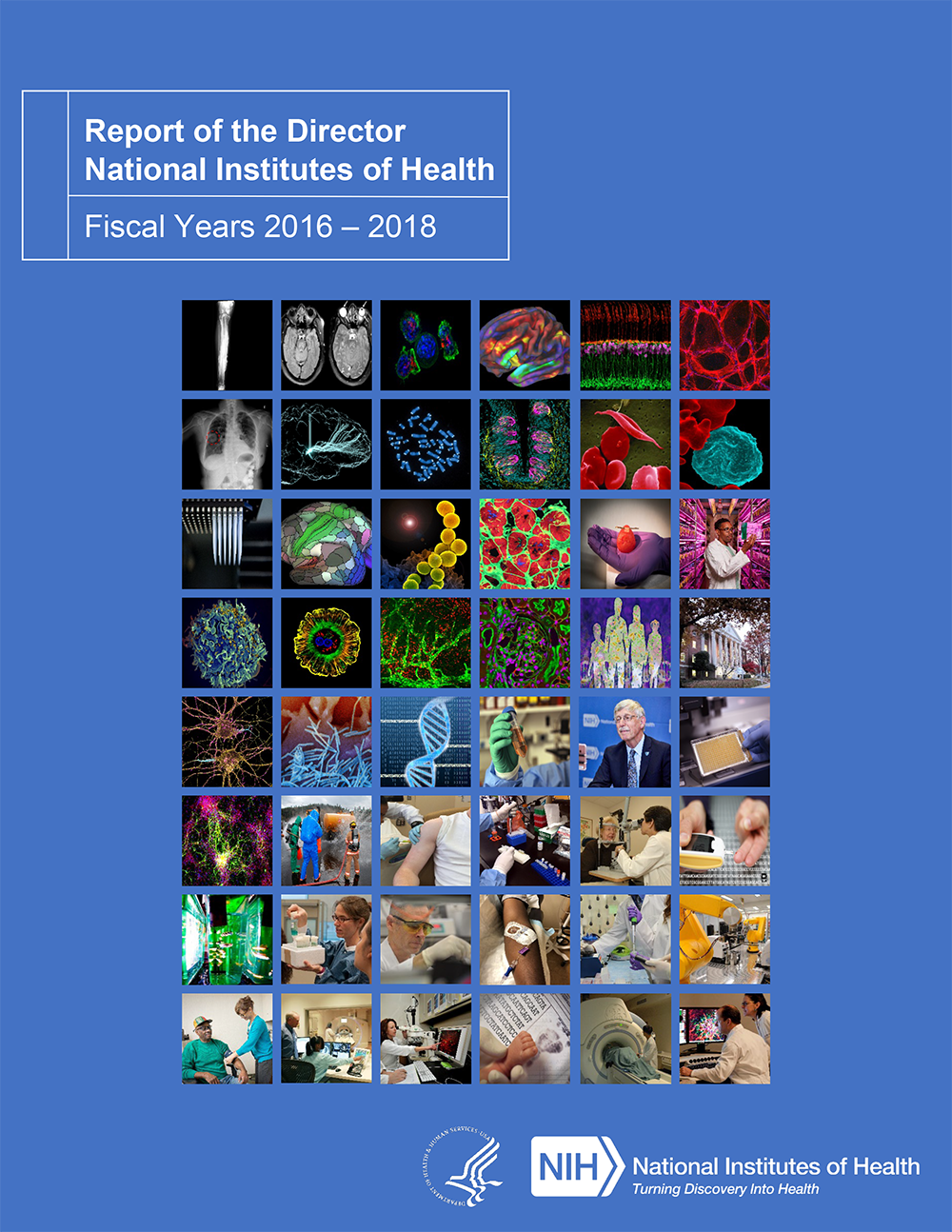NIH Triennial Report for Fiscal Years 2016, 2017, and 2018
How This Report Is Organized
Chapter 1: About NIH
Chapter 1 opens with a statement from the NIH Director assessing the state of biomedical and behavioral research. This chapter focuses on NIH structure, policies, and procedures, including operations of NIH extramural and intramural research programs. This chapter also addresses NIH activities to foster commitment to science, including both science education and literacy efforts, and training research workforce recruitment, training, and retention efforts.
Chapter 2: Overview of NIH Research
Chapter 2 provides an overview of the NIH research portfolio that covers the following topics:
- Basic research
- Preclinical translational research
- Clinical research
- Postclinical translational research
- Clinical and community practice
- Identifying public health needs (epidemiology)
- Infrastructure, research resources, and technology development
Chapter 2 begins with a brief introduction to the continuum of biomedical research at NIH. The research continuum moves from basic research, to preclinical translational research, to clinical research, and finally to postclinical translational research. As reflected by the last step of the continuum, NIH works to ensure the uptake of research results by clinical practitioners and the public in order to bring the rich evidence base of NIH research to clinical and community practice, ultimately turning discovery into health. The introduction is followed by a more in-depth discussion of these stages of the bench-to-practice continuum at NIH, including information on the types of activities conducted at each stage across NIH Institutes and Centers (ICs) and the Office of the Director (OD).
Chapter 2 discusses key factors that drive the NIH research continuum. The chapter points out the importance of epidemiological research, which provides evidence of the association between disease and human biology, behavior, or environmental circumstances. The chapter concludes with an overview of the importance of NIH investment in research resources, infrastructure, and the development of new technologies, without which progress along the research continuum would not be possible.
Chapter 3: NIH Research Activities in FY 2016, FY 2017, and FY 2018
Chapter 3 presents a cross-section of NIH research activities during the fiscal years (FY) 2016, 2017, and 2018 reporting period that covers the following topics:
- Cancer
- Neuroscience
- Life Stages, Human Development, and Rehabilitation
- Chronic Diseases and Organ Systems
- Autoimmune Diseases
- Infectious Diseases and Biodefense
- Public Health Emergency Preparedness
- Rare and Undiagnosed Diseases
- Microbiome
- Minority Health and Health Disparities
- Emerging Technologies
- Research Resources and Infrastructure
Each of these topics, many of which are categories specified in the Public Health Service Act, is addressed in a separate section. They are grouped together in one chapter to address the intent of the statute in terms of presenting information on diseases, disorders, and adverse health conditions in a standardized format.
Chapter 4: Centers of Excellence
Chapter 4 addresses certain NIH Centers of Excellence, which are diverse in focus, scope, and origin. This report describes those NIH Centers of Excellence that were established by statutory mandate, representing a subset of NIH’s full complement of such centers. This chapter also provides overviews, progress reports for FY 2016, 2017, and 2018 (covering programmatic and research activities and outcomes), recommendations, evaluation plans, and future directions for the six congressionally mandated NIH Centers of Excellence programs, which are described in the order of their establishment:
- Alzheimer’s Disease Centers (1984)
- Claude D. Pepper Older Americans Independence Centers of Excellence (1989)
- Senator Paul D. Wellstone Muscular Dystrophy Cooperative Research Centers (2001)
- National Institute on Minority Health and Health Disparities Centers of Excellence (2001)
- Rare Diseases Clinical Research Network (2003)
- Autism Centers of Excellence (2006)
Appendices
The Appendices present reference documents and supporting data.
- Appendix A provides excerpts from the Public Health Service Act that set the legal mandate for this Biennial Report and the inclusion of certain contents within it.
- Appendix B provides the Report of the Advisory Committee on Research on Women’s Health.
- Appendix C provides information on actions undertaken to conduct or support research related to tickborne diseases and other vector-borne diseases.
- Appendix D provides the Report of Trans-NIH Research.
- Appendix E provides data on the National Research Service Award program (the primary NIH research training program), the National Library of Medicine training programs, and NIH graduate medical education activities.
- Appendix F provides the NIH report, Monitoring Adherence to the NIH Policy on the Inclusion of Women and Minorities as Subjects in Clinical Research.
- Appendix G provides a catalog of disease registries and other data systems.
- Appendix H provides information on actions undertaken to carry out scientific frameworks on recalcitrant cancer.
- Appendix I provides NIH funding levels for chronic diseases and organ systems.
- Appendix J provides information on Eureka Prize Competitions.
- Appendix K provides a list of acronyms that are used in this report.
